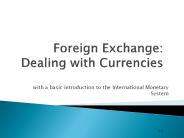Determination of Exchange Rates
1 / 21
Title:
Determination of Exchange Rates
Description:
Impact of Rising U.S. Interest Rates on the Equilibrium Value of the British Pound ... Foreign exchange markets react to any news that may have a future effect. ... – PowerPoint PPT presentation
Number of Views:15
Avg rating:3.0/5.0
Title: Determination of Exchange Rates
1
Determination of Exchange Rates
- International Finance
Dr. A. DeMaskey
2
Learning Objectives
- How are exchange rate movements measured?
- How is the equilibrium exchange rate determined?
- What factors affect the equilibrium exchange
rate? - How do central banks intervene in the foreign
exchange market? - How do expectations affect exchange rates?
3
Measuring Exchange Rate Movements
- Appreciation
- Depreciation
- Percent Change in the Foreign Currency Value
- Percent Change in the Home Currency Value
4
Exchange Rate Equilibrium
- Demand
- Supply
- Equilibrium Exchange Rate
5
Equilibrium Exchange Rate
Dollar Value of
S
1.50
D
Quantity of
6
Macro-Economic Factors Influencing Exchange Rates
- Relative Inflation Rates
- Relative Interest Rates
- Relative Income Levels
7
Impact of Rising U.S. Inflation on the
Equilibrium Value of the British Pound
Dollar Value of
S
1.50
D
Quantity of
8
Impact of Rising U.S. Interest Rates on the
Equilibrium Value of the British Pound
Dollar Value of
S
1.50
D
Quantity of
9
Impact of Rising U.S. Income on the Equilibrium
Value of the British Pound
Dollar Value of
S
1.50
D
Quantity of
10
Government Controls
- Foreign Exchange Barriers
- Foreign Trade Barriers
- Government Intervention in Foreign Exchange
Market - Affecting macro variables, such as inflation,
interest rates, and income levels
11
Expectations
- Foreign exchange markets react to any news that
may have a future effect. - Institutional investors often take currency
positions based on anticipated interest rate
movements in various countries. - Because of speculative transactions, foreign
exchange rates can be very volatile.
12
Role of Expectations
- Signal Impact on
- Poor U.S. economic indicators
Fed chairman suggests Fed is unlikely to cut
U.S. interest rates A possible decline in
German interest rates Central banks expected
to intervene to boost the euro
13
Interaction of Factors
- Trade-Related Factors
- Financial Factors
- Trade-related factors and financial factors
sometimes interact.
14
Factors Affecting Exchange Rates
Inflation Differential
U.S. Demand For Foreign Goods Foreign
Demand For U.S. Goods
U.S. Demand For FC Supply of FC For Sale
Income Differential
Govt Trade Restrictions
Exchange Rate Between the Foreign Currency And
the Dollar
Interest Rate Differential
U.S. Demand For Foreign Securities Foreign
Demand For U.S. Securities
U.S. Demand For FC Supply of FC For Sale
Capital Flow Restrictions
15
Government Intervention
- Reasons
- Direct
- Sterilized
- Non-Sterilized
- Indirect
- Government Policy
- Government Barriers
16
Central Bank Intervention
Nonsterilized Intervention To Strengthen the C
Sterilized Intervention To Strengthen the C
Federal Reserve
Federal Reserve
Treasury Securities
C
C
Financial Institutions That Invest In
Treasury Securities
Banks Participating In the Foreign Exchange Market
Banks Participating In the Foreign Exchange Market
17
Effect of Expectations
- Currency values are determined by
- Inflation
- Interest rates
- Economic and political stability
- GDP growth
- Reputation of central bank
- In reality, however, exchange rates are affected
by expectations of these variables.
18
Asset-Market Model
- Currencies behave like other financial assets
- A nations currency can be thought of an asset
whose value is determined by the (expected)
economic performance of that nation... - Economic Factors Affecting the Value of a
Currency - Store of Value
- Demand for Liquidity
- Demand for Assets Denominated in the Currency
19
Central Bank Behavior
- Reputable central banks
- Are trusted by markets to maintain a currencys
purchasing power through sound monetary policy. - Tend to be independent.
- Have currencies that are more highly valued than
those issued by less reputable banks.
20
Currency Board System
- A currency board is a system for maintaining the
value of the local currency with respect to some
other specified currency. - Characteristics
- No Central Bank
- No Discretionary Monetary Policy
- For example, Hong Kong has tied the value of the
Hong Kong dollar to the U.S. dollar (HK7.8 1)
since 1983.
21
Dollarization
- Dollarization refers to the replacement of a
local currency with U.S. dollars. - Dollarization goes beyond a currency board, as
the country no longer has a local currency. - For example, Ecuador implemented dollarization in
2000.































